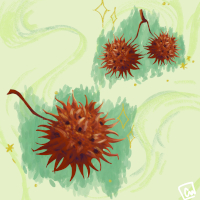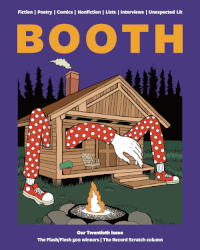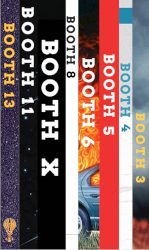An Essay by Robin Black
My five-year-old daughter has brought a coloring book home from her first day of kindergarten. It’s called Dinosaur Fire Safety. She’s wearing one of those plastic red firefighter hats I remember from my own childhood, and she wants to show me what she’s learned. We sit side by side on the couch, and I begin to read the first page out loud. “If your clothes catch fire. . .”
That is the opening text. Welcome to kindergarten, children . . . If your clothes catch fire. . . While I have been home all day imagining every danger my daughter may encounter, she has apparently been hearing about them all.
“Look, Mommy.”
The illustration shows a dinosaur—a brontosaurus, I believe —and my daughter has colored him orange. There’s a birthday cake on the table, and a card that reads Happy Birthday Max. And right away I find myself wondering why Max? Brontosaurus Maximus. perhaps? Or maybe his parents just liked the name. It’s impossible to know.
Max is opening a gift, pulling on the ribbon, grinning with massive, pointy teeth exposed. But unfortunately, in his entirely understandable enthusiasm, he has brushed his sleeve against a candle on the cake and seeing this, I can tell that smile is doomed.
My daughter has colored the cake purple. She hasn’t colored the flames shooting down Max’s sleeve, but even as mere outlines, they are obviously intense. There are six candles so Max must be turning either five or six. (I don’t know if dinosaurs light an extra candle for good luck. It would be pretty ironic if the lucky candle were the one burning through his shirt—the kind of plot twist that leaves you feeling a bit sick.)
My daughter is looking up at me.
“That seems kind of scary,” I say.
“It isn’t,” she says. “It’s not.”
I’m not going to argue with her, but it is.
I turn the page.
Page Two: Don’t panic!
“Oh, my,” I say.
The flames have spread to the back of Max’s shirt, and my own impression is that, notwithstanding the advice of the text, Max is panicking. My daughter has colored him red. And—not just because I’m her mother—I think that choice, the increased intensity of the hue, is a good artistic move, conveying as it does the heightened danger of his situation. His shirt is blue and the flames themselves, pouring off his back, are an oddly terrifying grassy green. Max’s tongue hangs way out of his mouth and a trail of smoke chases him. I take it from the angle at which he’s leaning that he’s in a big hurry. His eyebrows have been drawn as two lines jumping about an inch above his head. He is, to be clear, the picture of panic. Panic personified. In dinosaur form.
“Do you even know what panic is?” I ask. “Would you know how to not panic?”
She shrugs. “Silly Mommy,” she says, and then, “Turn the page.”
Page Three: Stop, drop and roll!
Whoa, this must be some good advice. Because Max here looks like he’s doing something he really enjoys. Maybe a little too much. He’s curled up on the floor, his three-fingered hands crossed over his chest. He’s smiling and—just FYI—I see that with his lips together, only two of his triangle teeth protrude from his mouth.
It’s probably not important to the story, but as I look at the picture, I realize that I like knowing Max at this level. I appreciate the care that has been taken with the physical details. I appreciate knowing what I do not need to know.! It is through just such little details that attachments are formed.
His legs are kind of slung one over the other and his tail seems to be floating just behind him, out of the way. There are no flames in evidence, none at all, just two arrows pointing towards Max’s rear end. And I know—because my daughter tells me—that these arrows mean he should roll. They are a form of instruction for Max, for my daughter, for the reader in general. Stop, drop and roll.
But to me the instructions are unclear, and they aren’t the compelling part. I find myself much more interested in that expression of pure oblivious joy on Max’s face. I don’t care about the arrows pointing toward his big, happy ass. My daughter has given this picture a kind of once-over scribble, in blue this time, indicating boredom. At five, I probably would have done much the same. I might not have known what I was seeing. I might well have missed the import of that thought-free ecstasy so evident in Max.
“Turn the page, Mommy,” my daughter says. And so, with some reluctance, I do.



